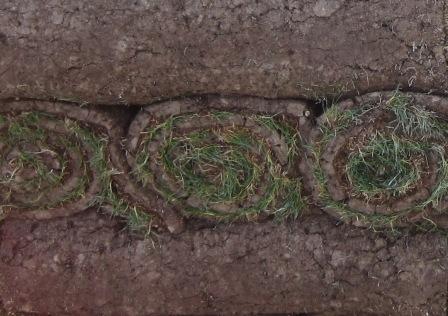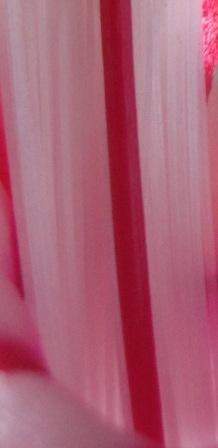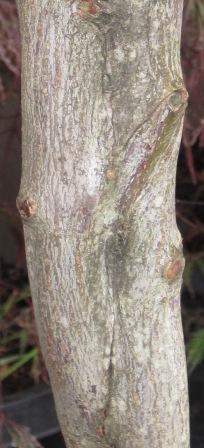Another easy one, or else you guys are just too smart! It is indeed a mistletoe. Gold stars to KB, John, Kandi, and Deb, and an extra point to Jane for identifying the genus (Phoradendron). I believe it’s Phoradendron bolleanum, an introduced species which parasitizes Cupressus arizonica (Arizona cypress).

In any case, I chose this puzzle plant in keeping with the holiday season! Thanks for playing!
Category: Diversions
Little green mystery
Cirque du Poinsettia
Last week I brought up the seasonal topic of poinsettias. There are so many cultivars to start with, it’ll make your head spin. Twenty five new varieties were introduced in 2009 alone. One
of the major breeders lists 36 RED varieties.
But for painting and glitter, growers
and retailers stick to “white” (actually a very pale yellow to cream –
see last week’s ‘Polar Bear’ post) or possibly light pink. The trend had a good start in Europe and crossed the pond in 2004. I
n 2005, I toured a Denver area greenhouse and saw my first air-brushed point. They were doing a specialty Broncos theme with bracts sprayed deep blue and orange and plopped into a football-shaped pot (with the season Denver’s having this year, I imagine sales are down). The “team colors” theme is everywhere now. Nothing says Christmas like maroon bracts (looked more like dried blood) with orange glitter – the interpretation of a Hokie poinsettia, available at our local Kroger. Different. Please comment if you’ve seen a weirder color combo (are there Steelers ones yet?!).
Nationally, independent garden centers note they can’t keep pigmented points in stock, despite charging upwards of $9 more for a painted 6” point than a regular one.
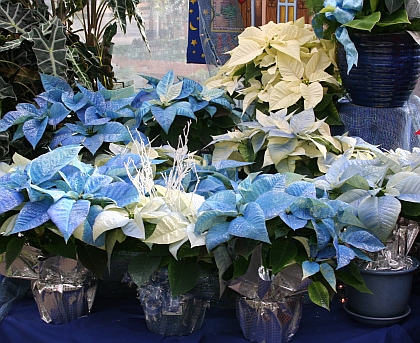
Blue poinsettias at McDonald’s Garden Center in Virginia Beach – a best-seller.
I’ve not seen any studies determining if the dye alters the post-harvest longevity or not; anecdotal evidence suggests it doesn’t have much effect. Just don’t splash them with water – the dye will run. Growers are careful to paint only mature poinsettias with fully-expanded bracts, or else suffer the poinsettia equivalent of bad roots (a la Lindsey Lohan). One of best-known of the poinsettia painters is at K&W Greenery of Janesville, Wisconsin. The owners have carved out their high-end niche by employing an artist to do the air-brushing and glitter-sprinkling, treating each one as an individual work of art. Art that will die in a heartbeat if you forget to water it, unfortunately. But the mother of all poinsettia growers/retailers in Ellison’s in Brenham, Texas. They’ve turned the season’s opening each year into a hugely successful, candle-lit, wine-pouring party. The Today Show even stopped by a few years ago. The Ellison’s tree photo has been making its rounds on the internet for so long, I don’t even know who to credit.
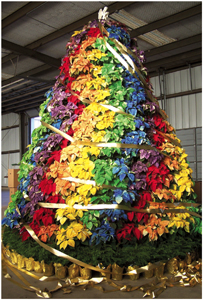
Fa la la la la (is that enough “la’s”?)
Whether you take your poinsettias painted, straight up, or not at all – happy holidays!
Friday puzzle unrolled
I knew this one was pretty easy, but I have my reasons (below). Gold stars to KB, Jim, John, and Dave for correctly identifying rolls of sod (and they do seem thin, Peter):
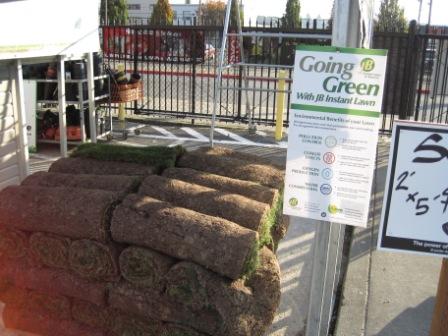
Yes, sod. I dislike instant lawns; they never look good for very long, at least in my part of the country. And getting rid of sod (as we have in our landscape) is a nightmare with that *%&$^ plastic mesh in which the grass is embedded. It breaks up into little bits that are constantly coming to the surface.
I don’t have an axe to grind about lawns; my philosophy is that if you want a lawn and can afford to maintain it well, more power to you. But what’s wrong with the old fashioned way of seeding a lawn? Sure, it takes a few more weeks to "grow your own", but seeded lawns look more natural and last much longer.
Friday’s puzzle
Candy cane unwrapped
Wow, what a bunch of great guesses this week! All of them are logicial…but only Deb guessed it was a Christmas cactus (actually a Thanksgiving cactus – Schlumbergera truncata) :
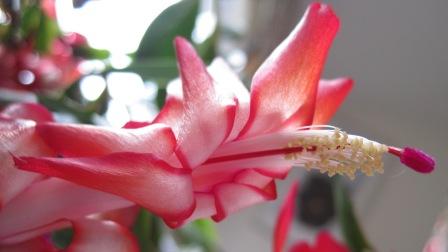
In any case, I thought this was a festive way to start the holiday season. (And please, no catty comments about my obsession with plant private parts.)
Candy cane mystery
Trunk teaser untwisted
Good guesses over the weekend on what caused the twisty looking trunk structure in Friday’s puzzle. Here’s a larger photo:

Nancy and Paul both got this one – it’s two trunks fused together. I have no idea whether the production nursery grew two saplings together on purpose or accidentally, but here’s one reason that this tree might be a problem down the road:
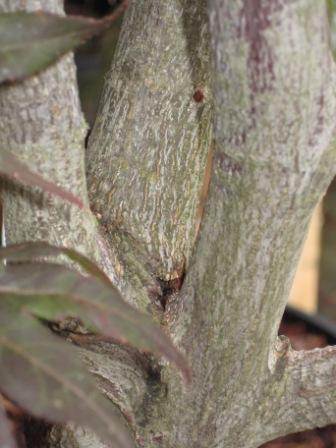
This area is ripe for disease, as water will collect in the crotch. In fact, the area is already discolored and could be diseased already.
One thing I hadn’t noticed when I took the top picture were the price tags on the nearby pots. They say it all – W(hy) O(h) W(hy).
Needless to say, I hope, is that you wouldn’t want to buy this plant.
Trunk teaser
Mysterious glowing object identified!
Ed, Wes and Paul all correctly identified Friday’s flower as a morning glory, probably an Ipomoea spp. (They also made me feel rather soiled for pedaling flower porn. Sheesh.)

What I find fascinating about these flowers is the unearthly glow at the center. They’re pollinated by bumblebees among other species, and bees see best in the blue-violet-ultraviolet range. If we were able to see this flower under UV light, you’d see those white areas become completely dark, creating a bullseye for bee approach.
Here’s why the white areas turn dark. The pigments in a white flower are flavonoids, which absorb UV radiation and reflect visible light. We don’t see into the UV range, so to us they look white (all that visible light bouncing back). But bees and some other insects do see UV light, and these flavonoid pigments create patterns to help them find nectar and pollen.

